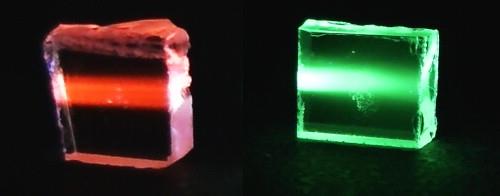Effects of ultraviolet excitation on the spectroscopic properties of Sm3+ and Tb3+ doped aluminophosphate glasses |
| |
| Affiliation: | 1. Department of Physics & I3N, University of Aveiro, 3810-193 Aveiro, Portugal;2. Department of Optospintronics, National Institute of R&D for Optoelectronics, INOE 2000, 77125 Magurele, Romania;3. Department of Materials Science, CENIMAT/I3N, Faculty of Sciences and Technology, Universidade Nova de Lisboa, 2825-516 Caparica, Portugal;1. Laboratory of Materials Engineering and Environment (LR11ES46), BP 1173, ENIS, Sfax University, Tunisia;2. I3N and Physics Department, Aveiro University, 3810-193, Aveiro, Portugal;1. I3N and Physics Department, University of Aveiro, 3810-193 Aveiro, Portugal;2. CNRS, 2 Rue Henry Dunant, 94320 Thiais, France;1. Department of Materials & Ceramic Engineering & CICECO, Aveiro University, 3810-193 Aveiro, Portugal;2. Physics Department & CICECO, Aveiro University, Aveiro, Portugal;3. Department of Physics and I3N, Universidade de Aveiro, 3810-193 Aveiro, Portugal;4. LCA- Central Analytical Laboratory & CICECO, Aveiro University, Aveiro, Portugal;5. IFIMUP and IN-Institute of Nanoscience and Nanotechnology, Departamento de Física e Astronomia da Faculdade de Ciências, Universidade do Porto, Rua do Campo Alegre, 687, 4169-007 Porto, Portugal;1. Laboratoire de Physique Appliquée, Faculté des Sciences, B.P. 1171, 3000 Sfax, Université de Sfax, Tunisia;2. Equipe des Hydrures Métalliques, Laboratoire de Mécanique, Matériaux et Procédés, Ecole Nationale Supérieure d’Ingénieurs de Tunis (ENSIT, Ex ESSTT), Université de Tunis, 5 Avenue Taha Hussein, 1008 Tunis, Tunisia;3. I3N and Physics Department, University of Aveiro, 3810-193 Aveiro, Portugal;1. Laboratoire de Physique Appliquée, Faculté des Sciences, Université de Sfax, B.P. 1171, 3000 Sfax, Tunisia;2. I3N and Physics Department, University of Aveiro, 3810-193 Aveiro, Portugal;3. Laboratoire de Physique Computationnelle des Matériaux – LPCM, Université Djillali Liabes de Sidi Bel-Abbes, 22000 Sidi Bel-Abbes, Algerie |
| |
| Abstract: | 
Li2O–BaO–Al2O3–La2O3–P2O5 glasses optically activated with rare earth ions with the 4f5, and 4f8 electronic configuration (Sm3+ and Tb3+, respectively) were analyzed by Raman spectroscopy, absorption, excitation photoluminescence, decay curves and temperature dependent photoluminescence. The spectroscopic characteristics of the as-prepared and heat treated samples at temperatures below and above Tg were studied as well as their room temperature photometric properties under ultraviolet excitation. All the doped glasses exhibit typical signatures of the lanthanides in their trivalent charge state. For the samarium doped glass heat treated at 250 °C (<Tg) the Sm2+ luminescence was also observed. The analysis of the luminescence efficiency was performed in the interval range of 14 K to room temperature, where the integrated intensity of the luminescence was found to decrease for the Sm3+ and Tb3+ ions in the studied temperature range. Luminescence decay curves were found to be non-exponential for the 4G5/2 → 6H7/2 and 5D3 → 7F4 transitions of the Sm3+ and Tb3+ ions, respectively. The results strongly suggest the occurrence of energy transfer processes through cross relaxation phenomena, mediated by dipole–dipole interaction in all the studied samples. The decay of the 5D4 → 7F5 emission of the Tb3+ ions was found to be single exponential with a time constant of ∼3.1 ms. Based on the spectroscopic characteristics, models for recombination processes are proposed. The room temperature luminance photometric properties with ultraviolet excitation show that the samarium doped glasses have much lower luminance intensity (around 0.3 Cd/m2) when compared with the 6–7 Cd/m2 observed for the terbium doped ones. |
| |
| Keywords: | Photoluminescence Lifetimes Rare-earth ions Raman Luminance Glass |
| 本文献已被 ScienceDirect 等数据库收录! |
|

